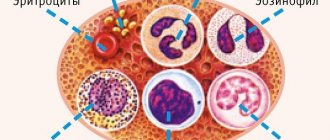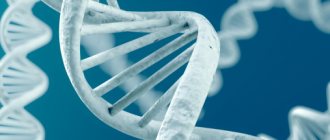The essence of a biochemical blood test
The state of the blood can be used to judge a person's health. The most informative type of laboratory test is biochemical analysis, which indicates problems in different parts of the organ system. Yes, if the pathology has just begun to develop and no obvious symptoms appear, the biochemistry indicators will differ from the norm, which will help prevent the further development of the problem.
Almost all areas of medicine use this type of research. A biochemical blood test is necessary to monitor the functioning of the pancreas, kidneys, liver, and heart. Based on the results of the analysis, you can see deviations in metabolism (metabolism) and begin timely therapy. By donating blood biochemistry, you can find out which microelement the body lacks.
Depending on the patient’s age, the panel of required tests changes. For children, the studied indicators are lower than for adults and the norm values vary depending on age.
A blood biochemistry test is mandatory for pregnant women.
Women should take the research responsibly, because the health and intrauterine development of the unborn child depends on it.
Control sampling is carried out in the first and last trimester. If constant monitoring is necessary, tests may be ordered more often. Sometimes, indicators deviating from normal values may indicate several diseases at once. Therefore, only a specialist can establish a diagnosis and prescribe a treatment method based on the results obtained. The number of indicators for the study is determined individually for each patient and depends on the complaints and the intended diagnosis.
How testing is done
An immunoreactive insulin test is done after 8-12 hours of fasting. The laboratory technician draws blood into a special tube with an anticoagulant substance. Using a centrifuge, plasma and blood cells are separated and cooled to -40° C. After the liquid part of the blood has separated, it is frozen at -200° C. In this form, the biomaterial is placed in a test system and the results are evaluated. Some laboratories require a repeat blood sample 2 hours after the first draw to assess hormone secretion. The patient should still be hungry at the time of re-collection.
There is another research method. The patient on an empty stomach is given glucagon-free insulin orally or intravenously at a rate of 0.1 units per kg of body weight. After this, blood samples are taken every 30 minutes for 2 hours. Normal values (µU/ml) should look like this:
- 30 minutes after the load, immunoreactive insulin increased to 25-231.
- 60 minutes – 18-277.
- 120 minutes – 16-167.
- 180 – 4-18.
Based on observations, it is noted that with oral administration of glucose, the release of insulin is greater than with intravenous administration. It has also been noted that with age, the pancreas loses sensitivity to glucose, but the level of maximum secretion remains constant.
Indications for analysis
A biochemical blood test can be prescribed both for preventive purposes and for the need to determine which organ has failed. The attending physician must determine the need for this examination, but in any case it will not be superfluous, and you should not be afraid of it.
Depending on the clinical picture of the disease, indicators will be selected that will “tell” with maximum accuracy about the processes occurring in the body.
Biochemical analysis is prescribed for diagnosis:
- Kidney, liver failure (hereditary pathologies).
- Disturbances in the functioning of the heart muscle (heart attack, stroke).
- Diseases in the musculoskeletal system (arthritis, arthrosis, osteoporosis).
- Pathologies of the gynecological system.
- Diseases of the circulatory system (leukemia).
- Diseases of the thyroid gland (diabetes mellitus).
- Deviations in the functioning of the stomach, intestines, pancreas.
The main symptoms for prescribing and drawing blood include pain in the abdomen, signs of jaundice, a strong odor of urine, vomiting, arterial hypotension, chronic fatigue, and constant thirst.
Depending on the results of the analysis, it is possible to determine the pathological process occurring in the body and its stage.
A biochemical blood test can be performed on a newborn child to exclude hereditary diseases. At a younger age, studies are carried out if there are signs of retardation in physical or mental development and for monitoring (diagnosis) of the disease. This test can detect genetic disorders.
Having received the results of the study, the doctor will make a diagnosis or prescribe additional examination options to make the picture of the disease more complete. It is possible to judge obvious disturbances in the functioning of internal organs if the values differ from the physiological norm corresponding to the patient’s age.
Useful video about biochemical blood test:
Immunoreactive insulin is elevated, what does this mean?
The secretion rate of protein-peptide hormone is determined by the level of glucose in the blood and is determined by the state of the endocrine system, autonomic central nervous system and nutrition. People with type 2 diabetes tend to have elevated insulin levels. This indicates intensive work of the pancreas and the formation of insulin resistance. A high concentration of the hormone in the blood may be associated with other pathological manifestations.
- Obesity.
- Liver diseases.
- The presence of neoplasms on the tissues of the pancreas.
- Diseases of the pituitary gland (pituitary gland).
- Muscular dystrophy.
- Itsenko-Cushing syndrome.
- Intolerance to fruit sugar and galactose.
- Nesidioblastosis.
- Insulinoma.
When deciphering indicators, it is necessary to take into account the period in which the results were recorded. For example, an immunoreactive insulin level of 77 after exercise is considered normal in the range from 30 to 120 minutes.
Indicators of a standard blood test panel for biochemistry
A biochemical blood test contains many indicators. To determine the pathology, the doctor prescribes a study only on certain points that are related to a specific organ and will reflect its functionality.
Read: Chronic iron deficiency anemia: everything you need to know about the pathology
The standard examination includes the following indicators:
| Index | Meaning |
| Glucose (blood sugar) | Refers to markers of carbohydrate metabolism and indicates problems in the endocrine system and liver. This test is used to monitor sugar levels in diabetes. Overweight people need to monitor their indicators and get tested more often. |
| Bilirubin | The amount of direct bilirubin is associated with the outflow of bile, and indirect bilirubin is responsible for serious liver pathologies. |
| Creatinine | Shows the functioning of the kidneys and affects energy metabolism in tissues. Its values are included with urea values. |
| Urea | This is a product of complete protein processing. It is completely excreted by the kidneys, therefore it carries information about their performance. |
| Cholesterol (cholesterol) | Refers to markers of fat metabolism and is necessarily determined in case of cardiovascular diseases. |
| AST | A small amount of the enzyme enters the blood. Most of it is synthesized in the liver. |
| ALT | Element from liver cells. A small amount is found in the heart and kidneys, from where it enters the bloodstream when cells are destroyed. |
| Total protein | Responsible for the normal process of metabolism, water metabolism and consists of globulins, lipoproteins, protamine and albumins. |
| Amylase | The level of the enzyme changes in diseases of the stomach and pancreas. |
| Albumen | One of the main proteins, which makes up about 30% of those contained in the blood. |
| Electrolytes (potassium, chlorine, sodium) | Necessary components for the water and electrolyte balance of the body. |
| Rheumatoid factor | Antibodies that are found in the blood of patients with rheumatism and arthritis. |
| Triglycerides | They are an indicator of lipid metabolism. Important as energy components. Indicators vary depending on age and gender. |
| Serum iron | This is the part of hemoglobin necessary for the transport of air and the formation of blood. |
What is immunoreactive insulin?
If you look for an answer to the question of what IRI is, then you mainly find information about the human protein hormone produced by pancreatic cells. Often nothing is stated about the definition of “immunoreactive” in the description of a substance. This is not entirely true. The fact is that in this context, “immunoreactive” is not a property of the molecule, but a technique for performing research.
In laboratories, the test is performed using biochemical analyzers and other test systems of the latest generation. Using highly specific immunometric studies, it is the level of insulin in the blood that is measured without identifying identical determinants in the form of proinsulin.
What can the results tell us?
The interpretation of the obtained analysis indicators consists of comparison with the normal values of each marker. After comparing the results, the doctor gives his conclusion. Further actions will depend on the severity of the disease. Self-medication is prohibited, as this can lead to irreparable consequences.
Interpretation of analysis results:
- The norm for total protein is 66-83 g/l. An increase can be observed with infectious diseases, dehydration or oncology. If the value is below normal, this indicates a pathological process in the liver or serious internal bleeding.
- Currently, doctors are struggling with a serious illness that is becoming increasingly common - diabetes mellitus. Normal values are in the range of 3.330–5.50 mmol/l. Absolutely healthy people also need to control their sugar levels by donating blood 2-3 times a year. An increase in indicators may occur if the endocrine system or adrenal glands are disrupted. A slight increase in values occurs in pregnant women and those prone to obesity.
- The proper functioning of the kidneys is reflected in the level of bilirubin. The rate of direct bilirubin is 0–7.9 µmol/g, and the rate of indirect bilirubin should not exceed 19 µmol/g. An increased value indicates liver dysfunction (jaundice, hemorrhage, leptospirosis).
- Aspartate aminotransferase in women should not be higher than 34 U/L; in men, the upper limit is 37 U/L. In females, the value may increase due to long-term therapy with hormonal (contraceptive) drugs. A significant increase is also observed in cases of heart disease or renal failure.
- Alanine aminotransferase values increase with the death of liver cells (cirrhosis, hepatitis) or blood diseases. The norm for women is not higher than 34 units/Ml, for men – 45 units/Ml. An increase in enzyme levels can be caused by a heart attack, acute hepatitis, or liver necrosis.
- Kidney health is monitored using urea and uric acid tests. The upper limit of the urea indicator (8.3 mmol/l) is exceeded if the kidneys lose their functionality (pyelonephritis, functional failure of urine outflow). This can be caused by both the disease and the age of the patient. If you have poor nutrition or diet, there may be a decrease in values. Excess uric acid is a signal of possible kidney failure, leukemia, and exhaustion.
- Albumin values in the range of 32-52 g/l indicate normal protein levels in the blood. An increase may be caused by dehydration or problems with the kidneys or heart.
- Based on data on the concentration of creatinine in the blood, the functionality of the kidneys is judged. For women, the norm is 53 – 97 µmol/l, for men – 62 – 114 µmol/l.
- The norm for sodium is 137–145 mmol/l, chlorine – 98–106 mmol/l, potassium – 3.5–5.5 mmol/l.
- Amylase, which is included in the biochemical blood test, consists of two values. The norms of alpha-amylase are 27-100 U/l, pancreatic amylase is up to 50 U/l. An increase in indicators occurs with serious disturbances in the gastrointestinal tract (pancreatitis, cholecystitis, peritonitis). A decrease in the norm is possible during pregnancy.
- Cholesterol increases with atherosclerosis, anemia, and cancer pathologies. This value is different for men and women and also depends on concomitant diseases. In a normal state, “good” cholesterol (high-density lipids) should exceed “bad” cholesterol.
- In pregnant women in the early stages, a deficiency of folic acid can be detected by biochemical analysis. This element is important for the formation of the neural tube of the unborn child. Therefore, during the first trimester, doctors recommend taking vitamin complexes for pregnant women.
Read: Blood clotting index, its meaning and norm
It is not always possible to diagnose diseases using a single biochemistry blood test. An experienced specialist, when making a diagnosis, is based not only on the results of laboratory tests, but also prescribes additional examination of the patient.
More information about biochemical blood tests can be found in the video:
Method of collecting biomaterial and delivering it to the laboratory
When testing for immunoreactive insulin, blood is taken from a vein using vacuum systems. The convenience of such systems lies in the removable needle holder with an adapter for the test tube. This design allows several biomaterial samples to be taken with one vein puncture. This is very important when conducting an insulin tolerance test, since the patient’s blood is taken 5 times throughout the test.
When taking biomaterial, a standard technique for obtaining venous blood is used. Heparin is used as an anticoagulant (a drug that inhibits blood clotting). The blood is immediately centrifuged at a temperature of +4° C. Serum and plasma are placed in secondary tubes and, if necessary, transported.
Serum iron binding capacity (total transferrin)
FVC norm in blood:
- Men 45 – 75 µmol/l
- Women 40 – 70 µmol/l
Features of preparation for the study: do not take iron supplements for a week before the test; 1 - 2 days before donating blood, you must limit your intake of fatty foods. Normal saturation of transferrin with iron: in men - 25.6 - 48.6%, in women - 25.5 - 47.6%. A physiological change in blood flow rate occurs during a normal pregnancy (increase to 4500 μg/l). In healthy children, FHR decreases immediately after birth and then increases.
High rates indicate: iron deficiency anemia, taking oral contraceptives, liver damage (cirrhosis, hepatitis), frequent blood transfusions. Low indicators of FSS appear: with a decrease in total protein in plasma (starvation, necrotizing syndrome), iron deficiency in the body, chronic infections.
Protein fractions
Protein fractions (SPE, Serum Protein Electrophoresis) - a quantitative ratio of fractions of total blood protein, reflecting physiological and pathological changes in the state of the body. Indications for the purpose of analyzing protein fractions: infections, systemic connective tissue diseases, cancer, nutritional disorders and malabsorption syndrome. It is possible to display results as a percentage, which is determined by the following formula: Fraction (g/l) x 100% =% Total protein (g/l)
Myoglobin
Myoglobin normal:
- in men - 19 - 92 mcg/l
- in women - 12 - 76 mcg/l
Myoglobin - muscle hemoglobin, takes part in tissue respiration. Freshly obtained blood serum or plasma is examined, and less commonly, urine. The normal level of myoglobin in urine is less than 20 mcg/l. Above normal: myocardial infarction, skeletal muscle strain, trauma, convulsions, electropulse therapy, inflammation of muscle tissue, burns;
Low miglobin: rheumatoid arthritis, myasthenia gravis; The concentration of myoglobin in urine depends on renal function.
Globulin
Globulins are proteins of the so-called acute phase of the disease. Globulins norm is 2-3.6 g% (20-36 g/l). An increase in alpha globulins is observed during inflammation in the body, stressful conditions: myocardial infarction, strokes, injuries, burns, chronic diseases, cancer metastases, some ailments, purulent processes. connective tissue diseases (rheumatism, systemic lupus erythematosus)
An increase in the content of alpha globulins is also possible in some chronic diseases, malignant neoplasms, especially their metastasis. A decrease in alpha globulins is seen in pathologies of globulin synthesis in the liver and decreased thyroid function (hypothyroidism).











